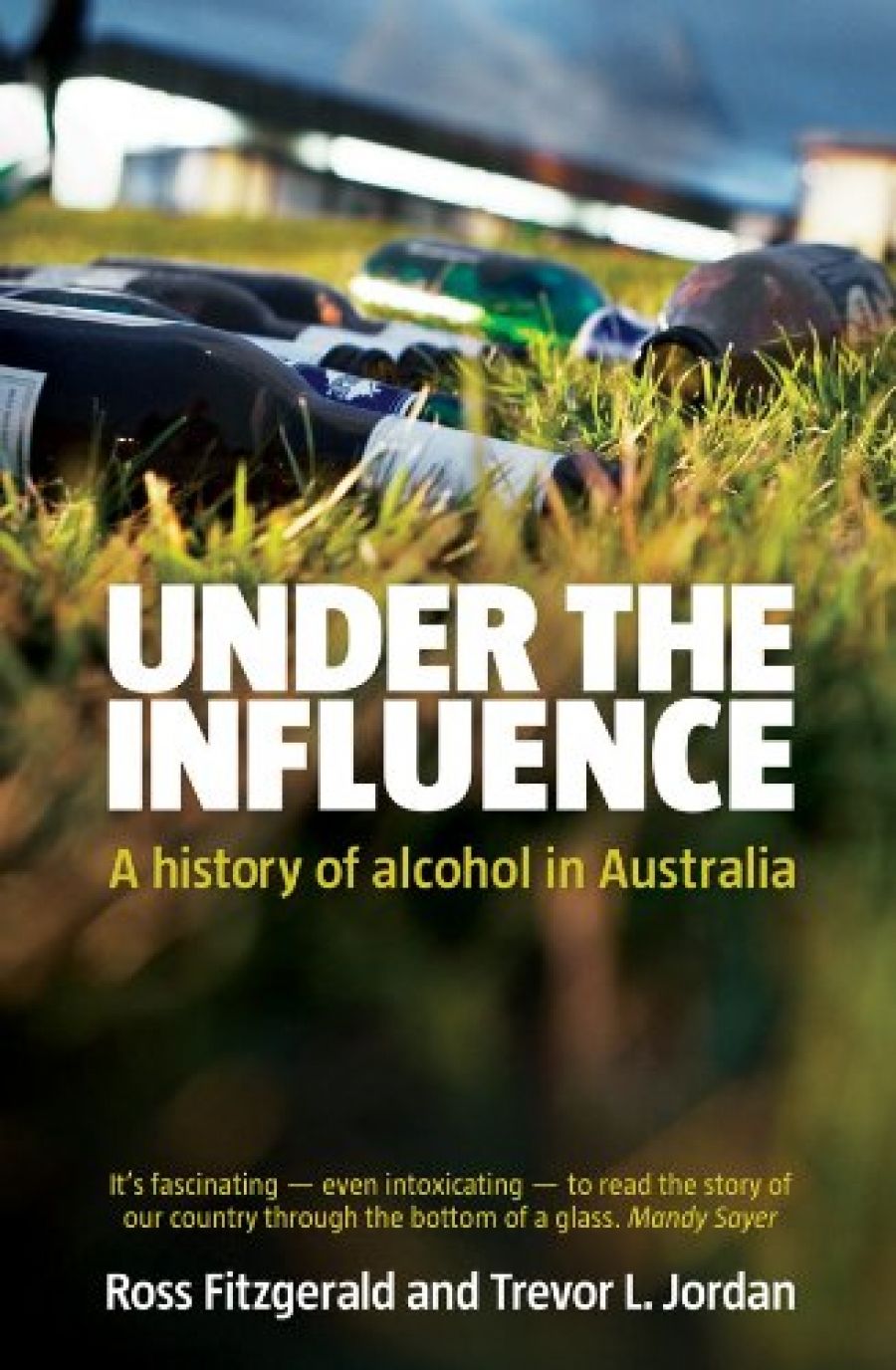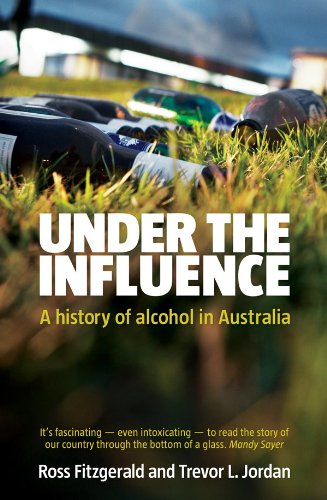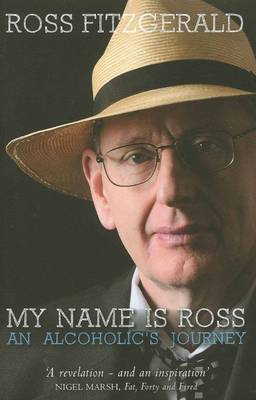
- Free Article: No
- Contents Category: Australian History
- Review Article: Yes
- Article Title: 'Time, gentlemen, please'
- Article Subtitle: Two very different books on alcohol
- Online Only: No
- Custom Highlight Text:
In Under the Influence, Ross Fitzgerald and Trevor L. Jordan look at Australian history and contemporary life through the lens of alcohol use in the community. ‘How a community or nation handles alcohol may be a strong indicator of its collective character’, they suggest. While seeking evidence for this, they throw up some fascinating material.
- Book 1 Title: Under The Influence
- Book 1 Subtitle: A history of alcohol in Australia
- Book 1 Biblio: ABC Books, $35 pb, 335 pp
- Book 1 Cover Small (400 x 600):

- Book 2 Title: My Name Is Ross
- Book 2 Subtitle: An alcoholic’s journey
- Book 2 Biblio: New South, $34.95 pb, 240 pp
- Book 2 Cover Small (400 x 600):

By 1918 beer could be transported throughout the country without the risk of rapid deterioration. In the 1880s, William Foster had introduced lager (with bottom-fermenting yeast) into Australia; this kept better than top-fermenting English-style beers. Foster was actually an American, something we tend to forget when talking about the iconic ‘Foster’s lager’. He made another notable contribution to Australian culture by supplying hotels with free ice during the summer months, thus embedding the notion of ‘cold beer’.
The temperance movement was surprisingly strong throughout Australia, particularly from the 1880s until the 1930s. ‘Local options’ were the most favoured approach, provisions whereby local areas could vote to prohibit or restrict alcohol outlets or sales. The authors link this to women’s suffrage. Local option votes were often defeated because the voters were mainly men, whilst the temperance supporters were mostly women. ‘The campaign to restrict hotels was the first political movement in Australia to involve large numbers of women and, indeed, the first instance of women uniting to effect legal reform and assert their rights.’
During World War I, several states passed ‘Six o’clock closing’ laws – ‘the most successful victory for the temperance movement’. Encouraged by this and the start of total Prohibition in the United States, the movement pressed on to persuade every Australian state to hold a referendum on Prohibition. However, each State rejected this move (and by then women were voters). This marked the end of the temperance movement as a serious political force in Australia. The authors comment that ‘unworkable prohibition laws could lead to a widespread reduction in respect for law and government’, something that certainly occurred in the United States. The Australian wine industry has been with us since the earliest days, but its exponential growth did not commence until after World War II. In an enlightening chapter, the authors describe its progress – from fortified to whites to reds; from bottles to flagons to casks; from boutique to mass production. The pressures of quality control and the consequent need for capital investment led to takeovers. The mergers and acquisition analyses are interesting; there is a parallel passage in the beer chapter.
With the historical groundwork laid, the authors turn to the harm that alcohol use can and does cause. The familiar problems are discussed: domestic violence; random violence; trauma on the roads; health costs; and so on. An interesting excursus discusses the notion that excess alcohol use is a ‘cultural’ aspect of Australian life. This is a cop-out for individual and corporate responsibility, the authors argue: ‘The focus on culture … tends to deflect moral responsibility from individual abusers and from the alcohol industry, at the same time re-apportioning a considerable amount of blame to us all.’ This sounds like Fitzgerald writing. As a reformed alcoholic himself, he clearly believes that the personal responsibility of individuals for their actions should be a key aspect in harm-reduction. Yet, in another passage, the authors acknowledge the fiendish complexity of tackling the drink problem: ‘We are always going back to the drawing board, cataloguing its manifold harms, searching for their causes and exploring options for eliminating, or at least alleviating, them.’
The drawing board they use for the enormously destructive phenomenon of Aboriginal alcohol abuse is provided by Noel Pearson. Pearson identifies five factors that have to be addressed: availability; money to acquire alcohol; time to use it; the fact that others are using it in the immediate environment; and a permissive ideology. He links this back to his overall view that welfare and other support for individuals should be re-linked to acceptable social norms of behaviour. This sounds fine, but a viable operational mode of implementing this approach across Aboriginal communities generally (as opposed to small pockets) is not easy to find.
This is a good book. It has plenty of fresh material, has been thoroughly researched and is well written. A bibliography would have improved it. But does it, as they foreshadowed, provide a strong indicator of the collective character of Australian society? One thing they argue is that Australian social life demonstrates ‘the normative equation of masculinity and mateship with drinking’ and that ‘many men and women don’t trust a person who doesn’t drink alcohol’. This view seems outmoded nowadays. ‘Non-drinkers’ are found and accepted at all levels of society. The coffee bar is as much a social hub as the pub. Australia, like everywhere else, is changing.
That brings us to the final point. Whatever drinking patterns tell us about Australia, this country is not much different from most other Western nations. We are quite well down the alcohol-consumption per capita scale – something like twenty-third overall. Everywhere one goes, one finds parallel debates. Our most distinctive and urgent problem relates to the indigenous population; otherwise Australia is simply part of the global village.
After reading this polished book, it is a matter of some amazement that one of the authors, Fitzgerald, has also written such a bad book – My Name is Ross. This tells the story of his plunge into alcoholism at the age of fifteen and his self-redemption beginning at the age of twenty-five. The main vehicle that has enabled him to do this, his ongoing prop, is Alcoholics Anonymous. ‘Despite still being an alcoholic, I haven’t needed to use alcohol or other drugs for decades,’ he states.
Fitzgerald admits at the outset that ‘the portrait I paint of myself is often not pleasant or appealing’. He is right. The book is self-satisfied, its style irritating. For example, Fitzgerald has evidently read Damon Runyon, so the book is liberally larded with characters such as ‘8 o’clock Mick’, ‘Broken Hill Jack’, ‘Raucous Dick’, ‘Cast-Iron Kate’, ‘Ukelele Jimmy’, ‘Circus Lil’ and ‘Car Yard Rod’. This is a tedious literary device that, if anything, diminishes the characters rather than highlighting them.
Fitzgerald expresses the hope that this book will sell well in Australia; he has never sold as well here as overseas, particularly in the United Kingdom. Possibly this hope has led him to use language and images that he thinks Australians will like: ‘shithouse’: ‘who the fuck I was’; ‘a load of cobblers’; ‘couldn’t act my way out of a paper bag’; ‘didn’t know if I wanted a fuck or a haircut’, ‘Edna’s voice used to make my nuts go up to my chin’; ‘close as a bee’s dick’, and so on. This faux populist style is obtrusive and silly.
Fitzgerald is an inveterate name-dropper. Sometimes the names are dropped in so that he can excoriate the person. For example, Gareth Evans and former Archbishop and Governor-General Peter Hollingworth get this treatment. Others are more fortunate. Peter Beattie was blessed in that Fitzgerald ‘was a lone and persistent supporter … as a potential ALP leader and Premier of Queensland’. Apparently Kevin Rudd, as head of the Queensland Department of Premier and Cabinet, treated Beattie less than generously. This provides Fitzgerald with the opportunity to attack him.
Fitzgerald’s relationship with wife, Lyndal, is crucial to him. But we are sometimes presented with too much information. Their sleeping and working arrangements are not of the slightest interest to the general reader. Worse still – and this is where the book becomes really ugly – there are various recitals of his sexual history and the women he has bedded. They are cut-out figures – no more than the detritus in his own life.
One female who is not a cut-out figure is his mother, Edna. Fitzgerald is venomous in his descriptions of her. Hearing that, as an infant, Fitzgerald was allergic to Edna’s breast milk is another example of too much information.
This is a truly lamentable book. It is hard to know why it was written, let alone published. Apparently, a key stage in the AA program is to identify and acknowledge the harm that one has done to others in the course of one’s alcoholism, and perhaps that is how this book began. Towards the end Fitzgerald, in a rare moment of genuine self-knowledge, says: ‘The truth is that, quite often, a little bit of me goes a long way.’ How right he is.


Comments powered by CComment